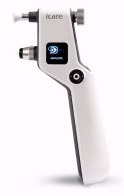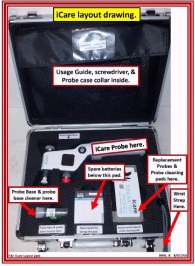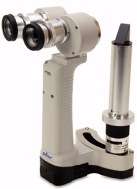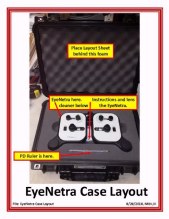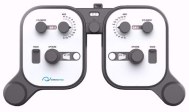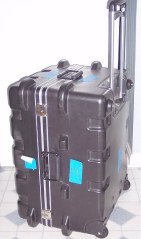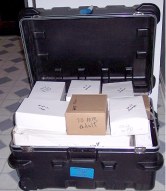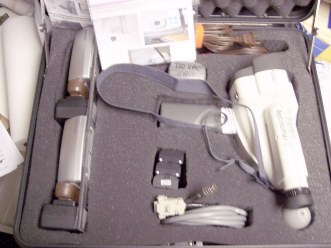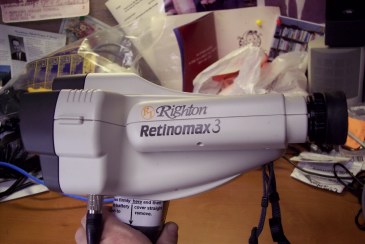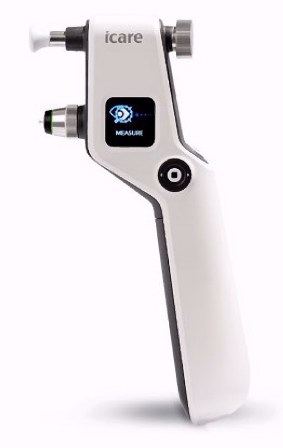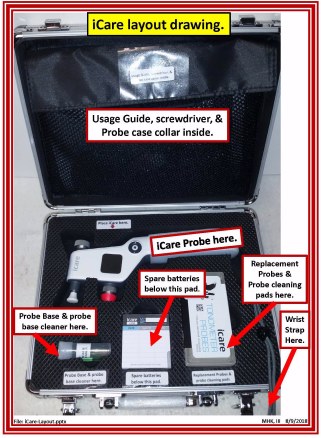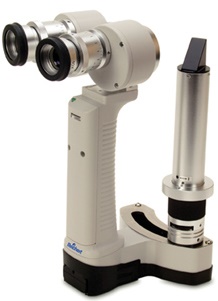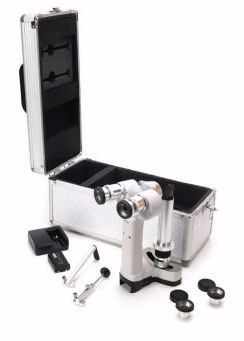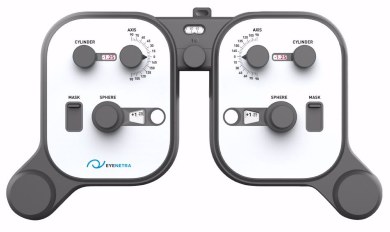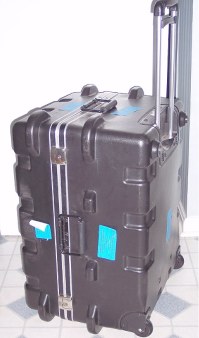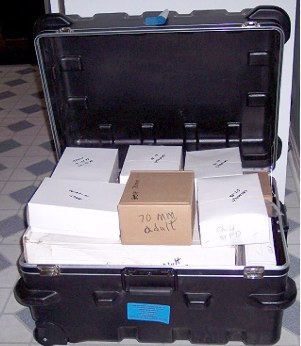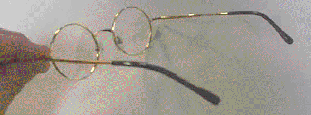 QUICK LINKS TO SECTIONS
QUICK LINKS TO SECTIONS
Click Below link.
|
Click Below link.
|
|
|
|
|
|
Click Below link.
|
Click Below link.
|
|
|
|
|
|
|
Check also adjustable eyeglasses at this link.
Announcing support for Retinomax 3 autorefractor. (1/16/2008) Updated 11/22/2010
Kendall Optometry Ministry now in addition to having 5 kits with Retinomax 2 autorefractors has 13 kits which contain the newly announced Retinomax 3 autorefractor. All kits are assigned to teams based upon availability. Below are pictures of the autorefractor in the case and also the autofractors separately.
Retinomax 3 in the case.
|
Retinomax 3 handheld autorefractor
|
|
|
|
The Retinomax 3 uses a Lithium Ion battery (vs NiMH for Retinomax 2) and is lighter and faster than the Retinomax 2. Due to the newer electronics the battery life is significantly improved. It is now possible to remove two of the chargers and 2 of the batteries from the kit and still maintain battery operation for up to 8 hours. This also removes about 4 lbs from the weight of the case.
 Equipment Information
Equipment Information
The optical equipment shown to the left can be provided to any Christian mission team who would like to enhance their ministry by the use of this equipment. Each team using the equipment provides a first time $2,000 damage and lost deposit (subsequent times are $1,000). All of this deposit is refundable (we don't even deposit the check unless necessary) should there be no damage or loss of the equipment. There is also a $200 non-refundable maintenance and support fee for the use of the equipment. (To allow for equipment alignment and repair). This fee covers up to 40 days of use of the kit. An additional $200 is charged for each additional 30 days and a fraction thereof.
The teams are responsible for the shipping costs of the equipment to/from Kendall Optometry Ministry. The average cost in the continental US is between $200 to as high as $250 (Washington State) one way. To save the teams money in August of 2011 we started including return shipping paperwork and then billing the team for both ways. Using this approach means the teams do not have to pay UPS store charges which in one documented case was as high as $600 more (from NC to Louisville) plus it is more convenient to them. This is an optional service.
Each team signs a legal agreement making them financially responsible for the equipment before it is shipped to them. Some teams are concerned about taking this responsibility. If that is the case, below is a link to an insurance company who will insure it while you have it in your possession.
(The above legal agreement is just a sample. We will send you
a completed agreement to sign before using the equipment.)
Here is a link to the value of that equipment: Equipment Value (Some newer kits are valued at $13,300)
Below is the information on the Equipment Insurance.
 Equipment Insurance
Equipment Insurance
For the equipment to be insured using the Excess Short Term Property insurance at least one team member must purchase the Volunteer Missionary Travel Insurance.
For an individual purchasing the Volunteer Missionary Travel Insurance and also the Excess Short Term Property Coverage, here is the breakdown of the premium assuming a 10 day trip and an equipment value of $13,300.
1 person x 10 days = 10 x $3.30(rate)= $33.00 total premium
$13,300.00 x .022 (rate based on a $100 deductible) = $292.60 + $33 = $325.60 total premium for both.
Other deductible options of $250 giving $13,300 x .02 = $266 +$33 = $299.00 total premium for both.
$500 giving $13,300 x .018 =$239.40 + $33 = $272.40 total premium for both.
and $1,000 giving $13,300 x .016 = $212.80 + $33 = $245.80 total premium for both.
are available on the application. You must provide them a copy of Attachment A of the Legal Agreement or other attachments if other equipment (like the iCare, EyeNetra, etc) have been ordered..
 Team Information Sheet
Team Information Sheet
Should you like to persue the use of the equipment further, you need to fill out an information sheet. Click this link to get a copy of this sheet. Also, you will now notice at te top of the sheet is a button which you can click when you have completed the form to E-Mail the information from the form to KOM. You can also print your own copy of the form. Here are pictures of the buttons:


Always be sure to print out your own completed copy of the form. Sometimes depending upon the E-Mail package that you have installed on your system, you may not believe that the E-Mail submission worked. In that case you should fax it to (502)-416-0015. We will then evaluate your request and let you know if equipment is available for your use during the requested timeframe. If it is not, we will consider the purchase of an additional unit should multiple teams also need to use the equipment during other parts of the year. Currently Kendall Optometry Ministry, Inc. owns 15 sets of this equipment. 4 sets contain the Retinomax 2 autorefractor while 11 sets have the Retinomax 3 autorefractor.
 Case Dimensions and Weight
Case Dimensions and Weight
Both the autorefractor and the optical black cases have dimensions of 18"Long x 15"High x 10"Deep. (43 linear inches). The autorefractor case weighs 22.5lbs (18.5 for Retinomax 3 case) while the optical case weighs 20.5 lbs. The laptop cases weight different amounts but on the average they weigh 13.5lbs. All must be carried on the plane and cannot be checked. One person can carry one black case and the laptop case. This is because the black case is the carry-on and the laptop case is considered a "personal" item. A second person carrys the other black case as carry-on luggage. Both black cases will easily fit in the overhead compartments in the plane. Call or E-Mail me if there are concerns.
If you carry eyeglasses in the KOM provided duffle bag at this link, it will be within the 72 linear inches required for checked baggage and will weigh up to 41 lbs. Since the limit is 50 lbs for checked baggage you can use this extra 9 lbs to carry readers, sunglasses and uncataloged used prescription glasses.
 NEEDS ANALYSIS
NEEDS ANALYSIS
Numerous teams travel throughout the world ministering for our Lord and Savior, Jesus Christ. One excellent method of ministry is to provide eyeglasses. These eyeglasses not only allow the person to read their Bible but to also improve their standard of living. Unlike providing a supply of medication, these glasses will typically be useful for several years. These teams are prevented from doing their best by a lack of training, professional assistance and proper equipment.
 ADDRESSING THIS NEED
ADDRESSING THIS NEED
Kendall Optometry Ministry (KOM) has assisted by providing numerous training manuals for the non-professional. Numerous different computer programs have also been written and provided either free or at a very small cost. The most useful program is called the Eyeglasses Inventory Program used to assist in the selection of 1000s of pairs of used prescription eyeglasses. With over 5 years in development, this program uses advanced optometry principles provided by experienced optometrists and described in textbooks. The intelligence built into this program gives the user the benefit of some of the experience and knowledge of these optometrists. Click here to learn more about this program:
 PROPOSAL FOR ENHANCED SUPPORT
PROPOSAL FOR ENHANCED SUPPORT
In addition to providing documentation and training, in 2004 KOM proposed that several teams join with KOM to purchase advanced optometry and computing equipment which can be shared by these teams. No one team can afford or justify the purchase of this equipment but together the cost is reasonable and the utilization of the equipment is far better. One set of this equipment was purchased and the debt has been liquidated. Two other sets were purchased later. In 2007 two more sets were purchased bringing the total to 5 sets. Other sets were purchased later.
 A PARTICIPANT
A PARTICIPANT
Each team which shared in the initial cost of this equipment (by donation) is called a participant. Equipment purchased by the participants will first and foremost be used by those participants but will be provided under certain circumstances to other teams. A participant makes a donation of at least $2,000 to purchase the equipment.
A participant has several advantages.
1) Participants have the first choice of the schedule for using the equipment. After the participant identifies their schedule for the year a non-participant can use the equipment,.
2) A participant will use the equipment the first time at no cost except for shipping and insurance plus a $200 maintenance and support fee.
3) On future trips the participant will pay a $1,000 refundable damage and loss deposit for the use of the equipment. However, they will be charged for the cost of shipping and insurance and the $200 maintenance and support fee. Other money donated will be used to keep the equipment in repair and to further the ministry of KOM.
4) A participant will also get a discount on all training materials, courses and products. They will also be able to participate in beta tests of new releases of computer programs.
 PROJECT COST:
PROJECT COST:
The following page shows the cost for the equipment involved. To the left are several pictures showing the components that have been purchased. These pictures also show the extreme care taken in designing equipment packaging.
Autorefractor in case: $10,000
Optical case: $ 2,000
Luggage packed case: $ 300
Laptop carryon case: $ 1,000
TOTAL: $13,300
 Suggestions for accurate use of the Retinomax 2 and 3 autorefractors:
Suggestions for accurate use of the Retinomax 2 and 3 autorefractors:
1. Put on the neck strap and keep the center/front lens clean.
2. Make sure the patient does not blink and tell the patient to look directly into the center lens of the autorefractor.
3. Establish a bridge with your hand between the instrument (on the left side) and the patientís head. With this bridge, if the patient moves, you move and the net movement is zero.
4. Before starting adjust the viewfinder so that you see the print inside clearly.
5. Be sure you do not shake. I always put my right elbow on the table holding the instrument in my right hand. If the patient is too tall for you, move your hand up the hand hold. Remember you can also put the viewfinder up and down. You want to make a direct shot into the plane of the eyes. You may have to move the viewfinder up for a direct shot into a short patient.
6. Look across the top of the instrument for the line in the plastic. Line that up vertically with the right eye. Now line up the line on the left side of the instrument horizontally. Donít expect to see the eye in the viewfinder until you are about an inch away. Find the eye by looking outside the instrument.
7. Be sure the instrument is set to measure the Right eye. If not press the Left/Right button until the right light is illuminated. Do not make a measurement (with the start button on the handle) until the circle of dots (called the mire ring) is clear and the two dots on the left and right are clear and visible. To make them visible you might have to either rotate the instrument and/or move your shoulders from left to right. Retinomax 3: Look at the rectangle in the top of the field of view and rotate the instrument in the direction of the arrow until you see OK above the rectangle.
8. Move the square into the center of the mire ring when all is clear. Then press the start button.
9. Hold the instrument steady while the measurement is being made. You should see R OK. (Right OK)
10. Press the Left/Right button on the top of the instrument until you see the Left button illuminate. Move to the left eye but keep in mind that the second you see the square go into the circle of dots even if the mire ring isnít clear, measurements will be made. If it isnít clear the measurements will not be accurate. To avoid it taking off and making a measurement, press the start button another time right after you have completed the right eye before measuring the left eye. That way you can position it, get the mire ring clear and press the start button again to make your measurement. You should see RL OK. (Right/Left OK)
11. When you have completed the left eye, press PRINT and you can see both readings in the viewfinder. Write them down on your postit note or send them to your attached printer or PC.
One thing to mention. You may not be able to read patients with cataracts or some severe eye conditions (like Macula Degeneration). You should dilate all patients 20 or less and if you are not pressed for time dilate between 21 and 30. Testing without dilation of young patients will give extremely poor accuracy. Sometimes very old patients have extremely tiny pupils (about 2mm in diameter). You will need to dilate them to make a measurement at all.
Here are the dilation drugs we recommend:
1. Proparicane Hcl .5% (Numbs the eye in about 5-15 seconds)
2. Tropicamide (1%) (will paralyze the focusing capability / accommodation of the eye and dilate it somewhat)
They take 15 minute to work and 4 hours to wear off.
 Other Equipment Information
Other Equipment Information
In addition to having autorefractors, Kendall Optometry Ministry now has the following other optical equipment.
 iCare Portable tonometer.
iCare Portable tonometer.
A tonometer is used to check the pressure in the eye to see if the patient has glaucoma. If the pressure is 21mg or more there is a 75% likelyhood of the patient having Glaucoma. A non-professional can easily learn how to use this instrument.
Click this link for a YouTube video which shows how to use it.
 Reichert Portable Slit lamp
Reichert Portable Slit lamp
A portable slit lamp can be used by optometrists and ophthalmologists to get a complete view of the eye. This instrument comes in a small cosmetic case which can easily be carried on the plane. Here is a picture of that unit:
 EyeNetra Portable Phoroptor
EyeNetra Portable Phoroptor
The phoroptor allows you to build and test a glasses prescription to see if it works for the patient. Here is a link describing how to use this equipment. It does not require an optical professional to use this equipment. It has a sphere range of -10.75 to +5.00 diopters in .25 diopter increments and 0 to -6 diopters in .25 increments and an axial range of 0 to 180 degrees.
Below is a picture of the unit.
 Field Assembly Kit.
Field Assembly Kit.
This kit consists of 400 lens and 200 frames. The lens are round lens in 46mm or 42mm diameter. The frames are from 57mm PD to 70mm PD. The lens are either spherical only or cylinder only. Spherical power goes from -15 to +15 in increments of .50. The cylinder power goes from -.25 to -4.00 in increments of .25. Assembly instructions and tools are in the kit. Teams are only charged for what they use. The cost for spherical power to to + or - 6.00 or cylinder up to -3.00 are $15 per pair including the appropriate frame. Higher powers are higher costs. Below is a picture of the kit.
